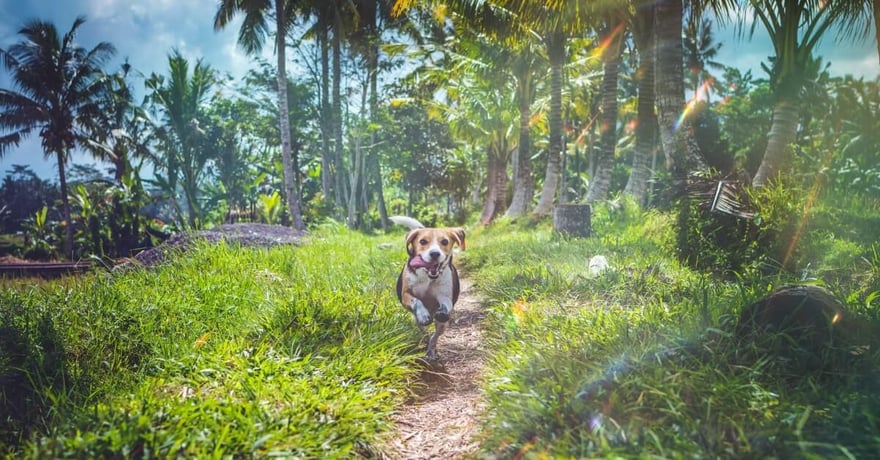Dogs And The Zoomies: 5 Things To Know

If you have a puppy, you might be familiar with their little moments of madness. One second, they might just be relaxing on the floor or in the garden, and then next thing you know, they’re running frantically in circles, chasing their tails, jumping on the furniture, and just generally going a little bit crazy. What you’re witnessing is colloquially known as “The Zoomies”.
Now, witnessing puppy zoomies can be a lot of fun, as you’re getting to see your dog completely untethered by order, even if just for a few minutes. However, if you’re unfamiliar with the concept, watching your little buddy acting so frenetically can be a little bit concerning, especially in a space with a few potential hazards.
We’ve put together this article to explain the basics of the zoomies in dogs and puppies, along with some tips for dealing with them so you can enjoy watching your dog zoom around in peace.
What Are Dog Zoomies?
Dog zoomies are known in veterinary circles as FRAPs, which stands for frenetic random activity periods, and in a literal sense, what you see is what you get. Basically, all dogs go through a period of having the zoomies, and while some “frapping” periods are longer than others, zoomies are generally known to last between one or two minutes. They are periods with sudden bursts of energy from a dog or puppy often characterized by a dog running very fast in enclosed pattern.
Why Do Dogs Get The Zoomies?
You can understand what the zoomies are by simply looking at your dog during a bout of them, but what’s slightly more complex is understanding exactly why this sort of dog behaviour might be taking place. Is it a release of pent-up energy? Is it mentally stimulating for dogs? There’s no exact science that explains why dogs go through the zoomies, but there are various theories that are generally agreed upon by different experts and vets.
Cause #1: Excitement
This makes sense, as zoomies are essentially a physical manifestation of excitement, so it’s only natural that it could be one of the leading causes. Things like meeting new dogs or people can trigger this excitement, as can receiving a new toy or simply being in a new place. Often it's a positive sign and means that your dog is happy.
Cause #2: Excess energy
In some cases, a dog may be displaying bouts of zooming if they’ve simply got a little bit too much energy to expend. If they’re having regular FRAP episodes, then perhaps you should consider taking them for more walks, playing more games with them, or even stimulating them with mental puzzles and games more often as a means of wearing them out in a less disruptive way.
Cause #3: Stress relief
Zoomies can be physical manifestations of stress, with the dog using them as a way to channel some of that nervous energy in a way that they can understand. If your dog has been through something a little stressful recently, don’t be surprised if their FRAPs pick up a little.
While these are the three main causes, there are also some other factors to consider, such as the zoomies being more common in younger dogs. It’s also worth noting that according to Marc Bekoff, who has a Ph.D. in Animal Psychology, the zoomies are perfectly fine and good for your dogs to enjoy.
Some Typical Triggers
While we now have a better idea of what actually causes the zoomies, you can also learn a little more about them by investigating some of the typical triggers of the zoomies. As you’ve probably deduced, the zoomies will strike after periods of excitement or discomfort, and if you’re trying to reduce your own dog’s zooming time, then you should pay attention to these typical triggers.
Trigger #1: Bathtime
It’s very common for a dog to jump out of the bath and begin a vigorous session of the zoomies, and this is nothing to be concerned about whatsoever. Dogs are wild animals, and this kind of grooming feels a little unnatural to them, so if they need a zoom after, just let them get on with it — they’ll be tuckered out in no time. The stillness, wetness, and smells are all things that the dog doesn’t really want, and there’s no better antidote than a quick case of the zoomies.
Trigger #2: After a walk
Now, this might seem a little confusing, as the zoomies are considered a side-effect of lacking physical activity, but hear us out. Being out in the world, with all its sights, smells, and sounds can be a lot for a dog, making them very excitable. If you finish your walk a little too soon, your dog might need to zoom the last bits of energy out of their system.
Trigger #3: Peer pressure
Dogs are actually a lot more easily influenced than you might think. The presence of other dogs, animals, or even children playing and having fun in their presence can bring on the zoomies like nothing else. Thankfully, if this is the case, the zoomies are probably a positive reaction!
What Age Do Puppy Zoomies Stop?
So, you’ve brought your furry friend home with you and they’re really making the most of their youth by zooming up and down the house — but when do puppies grow out of zoomies? Well, this is a question without a clear answer, because as you know, every dog is different, with their own unique personality and approach to life. That’s why we love them!
However, you can rest assured that the majority of dogs get most of their zoomies out in their youth, at least in terms of frequency. A puppy's energy level is typically much higher than with older dogs so this makes some sense. It’s around the ages of 6-7 years old that most dogs will slow down with their zoomies, while many dogs will have basically stopped having the zoomies altogether by the time they reach the age of 10-11.
While this may be the case for most dogs, you should remember that even senior dogs that are happy, healthy, and full of life can still have moments in the zoomies and that this is generally nothing to be concerned about.
Should You Stop Dog Zoomies?
When it comes to stopping dog zoomies, it’s useful to remember that there’s not really any reason to. Unless they’re around a lot of sharp edges, ledges, stairs, or ledges, you can generally just let zoomies run their course. If there are risks in their environment then crate-training your dog can provide a useful safety mechanism to prevent them hurting themselves.
As stated earlier, more mental and physical stimulation will help to reduce your dog’s zooming tendencies, but what could be more important is knowing how to manage them.
Some quick tips include:
- Don’t chase: This will only encourage the zoomies.
- Call them over: Hopefully, this should at least keep the zoomies in your eye line.
- Let them chase you: If you run away, your dog is likely to follow you.
As long as you can keep your dog safe, the best way to be rid of the zoomies is to simply let them get it out of their system — they’re only happy!
For all dog owners, consulting with your veterinarian when you have questions is always best. This is true of zoomies and anything else! The quality of your relationship with your veterinarian will determine many of your dog’s lifetime health outcomes.
Remember, regardless of your dog’s behaviour, choosing the right Canadian pet insurance policy in case of emergencies, injuries and accidents can save a lot of heartache. Get a quote from PHI Direct today to learn more.
Now you know everything you need to know about the zoomies in dogs, but what else is there to learn? For more interesting and helpful articles on pet ownership, visit the rest of our blog now.
Posted on July 11, 2022 | Categories: Pet Insurance DOGS Puppy Training
Share


